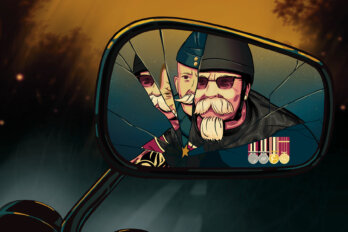Toronto’s vibrant Junction neighbourhood is located west of the city, where the old Canadian Pacific and Canadian National railways cross. Much like New York’s Bushwick or London’s Dalston, Toronto’s Junction was once a notoriously wild and untamed neighbourhood—so much so that Prohibition was still in place within its limits two decades ago. In recent years, however, it has seen a boom in condo construction and $5 lattes. A stroll along Dundas Street West, which runs through the Junction like bone marrow, reveals flea and farmers’ markets, antiques dealers, cafés, and craft breweries. Raw meets gentrified, and they collide in ever-interesting ways.
Drawn to the neighbourhood’s vibe, in late March 2016, I responded to an apartment listing posted in the Bunz Trading Zone, a local Facebook bartering forum that emerged from the city’s recent embrace of the sharing economy. Groups such as Bunz, the Really Really Free Market, and the Toronto Tool Library are living, thriving proof that there are Torontonians who would rather trade, lend, or donate their unwanted goods than toss or sell them. Many satellite Bunz groups have emerged to help people connect, such as the Bunz Dating Zone and the Bunz Home Zone, which now form a whole Bunz community—there is a real appeal to finding a roommate or dating someone who Bunzes with the best of them.
The morning of the apartment viewing, I found a small discarded green bedside dresser with one solitary drawer outside of an antiques shop. Its midcentury style had an odd, alluring beauty. Besides, it was free. Assuming the antique shop had dumped it there to clean house, I picked it up off the curb and popped it into the trunk of my car. I didn’t end up taking that apartment, but later that same week, I took another Junction flat, located a block away. I placed the bedside dresser in my garage to sit for the cold spring, collecting dust, until moving day came.
Four months later, as I prepared for my imminent move, I remembered the dresser. To my astonishment, it was full. There was a lot of junk inside: used glue sticks, baby powder, broken beads, and dried Tiger Balm. But in the back of the drawer sat a tea tin. Opening it, I found a trove of costume jewellery. Strange skull earrings, gold studs, massive rings too big for my fingers, odd necklaces with Monopoly pieces for charms—I could post them on Bunz and trade them for subway tokens or tall cans. Then, tucked in the corner, was a small roll of film. I put it aside, convinced my true treasure was a $2 bill from 1954 wedged into the back of the tea tin, depicting a stoic, young Queen Elizabeth II on a background of light salmon and malachite.
The collector’s bill could fetch anywhere from $50 to $1,000 at trade shows. I posted a photograph of the bill on Bunz with the caption “Shout-out to the people who put their dressers out on the curb without checking their drawers first.” The post received over 1,100 likes and hundreds of comments, including some from a few vendors who wanted to buy the note off me. Dazzled, I forgot all about the other items. Only weeks later did I remember the roll of film. Out of boredom and curiosity, I cycled over to my neighbourhood photo lab.
I walked up to the gruff man behind the counter and asked, “Has this roll of film been used?”
“Yeah, it’s been used.”
“Can . . . can you develop it for me?”
He saw right through me. “This isn’t yours, is it?”
I admitted that it wasn’t. On a whim, I added that if I could develop it, I might be able to figure out whose it was and return the photos.
“Ah,” he nodded. “Like Amélie.”
In the eponymous 2001 French film, Amélie is a character who finds the lost items of a stranger and goes out of her way to return them. The result is sheer joy. The stranger and Amélie feel light and airy, like the world is a beautiful, connected place. I wanted to do the same. To feel that connection with a stranger, to hold their trembling hand and tell them, “Hey, I saw your soul in your photographs. You did good.”
So I replied, “Yes. Yes, I am. I am the Canadian Amélie.”
Three days and $15 later, I had the pictures in my hands. I thought I might find boring vacation photos or a family dinner. Yet, all thirty-two photos turned out to be stunningly ethereal, telling a complex story with chiaroscuro, framing, juxtaposition, and depth. I recognized the location of the shoot: High Park, the largest wooded area in the city. There were images of cherry blossoms, of the capybaras in the petting zoo, of the rolling hills and lakeside ducks. And there were two faces. Both of them belonging to men. One of the men had a lean and lanky frame. The other had a large, scruffy beard. Both wore glasses. There were photographs of them on swings in flight, of them with their hands in a beam of sunlight, and of them with a chalk heart at their feet: all suggested romance. Were they on a date? The vibrant colours and the story hit me right in my chest. These men surely would want these pictures back. Why was this roll of film never developed? Why would they discard it so haphazardly on the curb?
I had to find the people responsible for this.
I turned once again to the Bunz Trading Zone.
The Bunz origin story is the stuff of lore. One night in Toronto, the founder-to-be, Emily Bitze, was short of funds and unable to afford the ingredients for dinner. Turning to her Facebook network for help, she created the trading group, originally intended for her own social circle, and it snowballed from there. When I joined the group in early 2015, there were around 4,000 members. That same year, Bunz launched its official bartering and trading app, which caters to most major Canadian cities and some American ones as well. To date, the main Facebook group has over 65,000 members in Toronto alone.
“It’s a community built on trust, on willingness to engage with one another,” says Eli Klein, the community manager at Bunz’s head office in downtown Toronto. “Most of our members heard of us through word of mouth.” Klein says that whether people join for economic concerns or just because it’s a millennial fad, what keeps them coming back is a strong shared belief in the ethos that Bunz espouses—namely, community betterment through trade.
That sounds like a hard sell, especially to world-weary Torontonians. We’ve been raised on “stranger danger,” and even well into adulthood, most of us don’t know anything about the people who live right next door. But Klein says that the popularity of Bunz speaks to a certain altruistic attitude. We may be trading a $50 purse for a $15 pound of ground coffee and not getting our value’s worth. But we’re not on Bunz to get dollar for dollar; we’re in it to be a part of our community.
A large portion of posts in the so-called Bunziverse are from low-income, underemployed, and vulnerable people. Every day, cash-poor university students, single parents, or newly arrived immigrants post in the group, asking for items to see them through until their next paycheque. The response to these posts is almost universally something along the lines of, “Here, I have what you need. I can drop it off to you. No trade needed. I have lots and am willing to share.” Bunz acts as a big middle finger to capitalism. As such, part of Bunz’s group rules include the right to post non-trade-related public-service announcements or requests for help. I was hoping my quest to find the people in this roll of film would fit into this ethos. Staring at the vibrant colours and beautiful framing of the thirty-two images, I craved a meaningful connection with these strangers. Maybe I wanted some of that colour and beauty for myself.
I posted the clearest photographs of the men’s faces. It wasn’t much to go on. They were wearing sunglasses; their faces were slightly obscured. I asked if anyone could identify them. My post went up at 7:04 p.m. I received messages, comments, and replies to my post instantaneously. People were “bumping” my post to the top of the page so that it would garner greater views and readership. They were tagging their friends to join in the search. The Bunz community really wanted me to find these two men. By 7:12 p.m., Bunz had identified them both. It was the most exciting eight minutes of my life.
The first man, the lean and lanky one, was Kenji. The second, the bearded man, was Amir. I searched for them on Facebook and messaged Kenji first. He confirmed he was one of the men. Kenji told me the photographs were taken a few years before, but they didn’t belong to him. They belonged to the photographer, a woman named Zahra. She was Kenji’s ex-girlfriend—and she had left Kenji for Amir.
My single, stupid reply to that was, “Oh dear.”
Kenji insisted there was no bad blood between them, and so I asked him a few more questions: Is Zahra a professional photographer? She must be an artist, no? Why was the roll of film never developed? What was it doing in a drawer on the curb in the Junction? Kenji was hesitant to reply to my messages. I could see he was reading them, but his responses became increasingly infrequent, until, finally, he stopped responding to me altogether. And I never heard from him again.
Kenji’s radio silence should have been an indicator to let sleeping dogs lie. But if I was truly to be the Canadian Amélie, I’d have to peel more of that proverbial, eye-watering onion. And so, I moved on to Amir, again on Facebook. Yes, he was the other man, he confirmed. Yes, Zahra was the photographer. He then admitted he hadn’t spoken to her in quite some time. He sent me the link to her Facebook profile so I could contact her directly and ended the conversation with a “Good luck.” I never heard from him again either.
In a world full of locked doors, I was going to use these photographs to open at least one, come hell or high water. And so twenty-four hours later, I reached out to Zahra. Before I could relay the amazing tale of how Bunz led me to her or compliment her ethereal photos, she responded, “Soooooo awkward. I’m so sorry that that happened…I’m super embarrassed.”
Wait, what?
In my mind, spurred on by the encouragement and excitement from the Bunz community, I had imagined she would be delighted by this effort to return her pictures. Instead, she asked me not to “show the photographs around.” I assured her that there was nothing indecent on the film, but Zahra was concerned that her “personal stuff was put out in the world.”
It was then that I realized this would not be like Amélie. No one would walk away from this feeling light and airy. All the people in Bunz who had helped me find Kenji, Amir, and Zahra had willingly chosen to be a part of this journey. But Kenji, Amir, and Zahra had most certainly not. I had, in fact, forced this upon them. I wasn’t making them feel happy; I was salting old wounds and rehashing old arguments. I had inserted myself in the middle of a love triangle.
Sometimes, we ignore what is right in front of us. We believe a false narrative because we want connection, or romance, or excitement. Even though I knew deep down that Kenji, Amir, and Zahra weren’t enjoying anyone’s enthusiasm, I felt an overwhelming desire for a good story—for a meaningful connection with strangers. Blinded by the Bunz ethos, I had become an intruder.
And so when I later met with Zahra, I knew it was only so she could quash any of my further attempts to post about her on Bunz. (Upon reflection, it could be said that even writing these words toes the privacy line, and that is an argument worth having. Yet, when I ask myself, “Is this a story worth telling?” I am forced to answer yes. But I have also changed everyone’s names.) We met at a café in the Junction on Dundas Street West, not far from where I originally found the dresser. As Zahra sat down across from me, I slid the negatives across the table to her and asked, “Do you want to hear how I found the roll of film?”
“Yeah.”
“So I was going to an apartment viewing near Annette Street, and I found them outside of an antiques shop—”
“Oh, I used to live above that antiques shop,” Zahra cut me off.
And the penny dropped.
“Above it?”
“Yeah.”
“You used to live above it?” I repeated.
“Yeah.”
I closed my eyes. I flashed back to late March 2016. The apartment I saw that day, after I had placed the dresser in the trunk of my car, was located above the antique shop. I had assumed the dresser was antique shop junk, but now I realized it had come directly from Zahra. The man who lived there, my would-be roommate, was named Luis. He had said, “My girlfriend is moving out. You would be moving into her old sewing room.” He showed me around, and I saw her furniture, her clothes, her decorations, her keepsakes. In the end, I had found another place to live and forgotten all about it until the moment Zahra was sitting across from me and looking at me with such disapproving eyes.
And I couldn’t blame her.
Because not only did I now know the intimate details of three of her ex-boyfriends, I had almost lived with one of them.
I asked her why she threw out the dresser without checking the drawer first. She told me it wasn’t hers. She didn’t recognize the other contents I found within—not the jewellery, not the $2 bill—and she couldn’t really give me an answer as to why she had never developed the roll.
I encouraged her to appreciate the photographs, but I could tell she wasn’t really interested in seeing these memories come to life. The negatives were surely bound for the trash again.
Zahra gifted me with a lovely small potted cactus for my trouble. And I never heard or saw from her again. Because, despite what I had hoped, she wasn’t my friend in real life. I couldn’t make her into one, nor could I make her feel light and airy about our interactions. It’s been said before that the magic of the Bunziverse is that the online community can facilitate real-life relationships—someone to trade with, someone to date, someone to share an apartment with. In my case, I expected a fine French film and all I got was a prickly cactus. Perhaps some things are better left to disappear into the ether. Or, in my case, the Ethernet.
I kept the developed pictures. They now have pride of place on my wall. They tell a complex story of love burning within the last dying embers of a Toronto summer.
So I figure someone ought to appreciate them.





